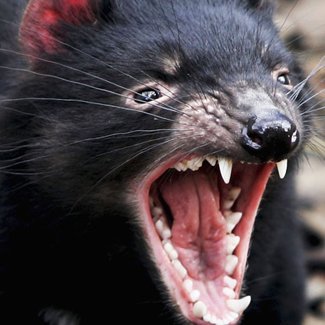Tassie devils and thylacines went extinct from the mainland at the same time

Tasmanian tigers and devils went extinct from mainland Australia at the same time, according to a new study conducted by the University of Adelaide, released today in The Royal Society.
Lead author of the paper Jeremy Austin tells Australian Geographic that the findings suggest that a common cause or causes were responsible for both animals simultaneous extinction.
To pinpoint the exact date of extinction 44 devil and thylacine fossils from across southern Australia were radio-carbon dated. These dates were then combined with 58 existing “high-quality” dates from previous research.
Using a complex mathematical method the researchers found that both species went extinct around 3,200 years ago, during the late-Holocene.
What caused their extinction?
As for what caused the extinction of these two animals scientists are still unsure, however, Jeremy says that there are three main theories.
The first is that climate change, specifically the sudden increase in ENSO activity around 4000-6000 years ago may have kick-started the extinction process on the mainland.

The other theories argue that the extinction of the Tassie devil and tiger from the mainland could have been caused by human hunting and competition from dingoes.
“Aboriginal human populations grew in size over the last 6000 years – some people believe that this increase in population size combined with direct killing of thylacines and devils may have caused the extinction”
“Dingoes were introduced to Australia around 4000 years ago and competition or direct killing of thylacines and devils by dingoes may have also caused the extinction.”
Both animals in poor health prior to mainland extinction
According to a study released late last year— the first to successfully sequence an entire thylacine genome— bother the Tasmanian devil and thylacine had very low diversity and poor genetic health long before the land bridge closed between Tasmania and the mainland.
“If we hadn’t hunted them [thylacine] into extinction the population would be in very poor genetic health like the devil… The thylacine would have been at a similar risk of contracting devastating diseases,” Andrew Pask, a biologist from the University of Melbourne, who worked on the project, told Australian Geographic.
Climate change, a danger to our native species
Jeremy says that if we were to accept that climate change was the critical factor in the extinction of these two animals from the mainland then it could help develop more informed conservation and management practices.
“We face a period of rapid climate change, with a range of other pressures like habitat loss, feral competitors, predators and new diseases. These are all recognised as major threats.
“I think we are beginning to get evidence that climate change and other factors can wipe out species across very large areas, the entire Australian mainland in the case of devils and thylacines.”

